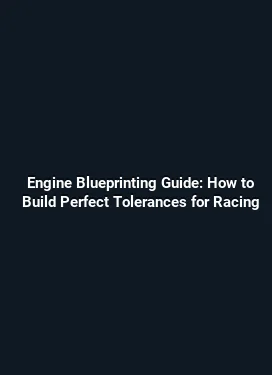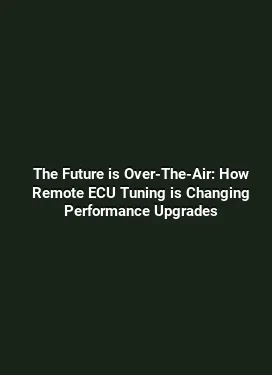Piggyback ECU vs Standalone ECU: Which is Better for Your Build?
Engine management systems play a crucial role in translating mechanical performance into reliable, track-ready power. The choice between a piggyback ECU and a standalone ECU hinges on how you drive, how you tune, and how you plan to evolve your setup over time. In this in-depth guide, we explore the core mechanics, tuning capabilities, installation considerations, and real-world use cases that guide the decision for many performance enthusiasts. By examining practical workflows, sensor integration, data logging, and common sticking points, this article aims to equip builders with clarity when designing a powertrain that matches both ambition and reliability.
Piggyback vs Standalone: Core Concepts and How They Differ

At the heart of engine management lies the control of fuel delivery, ignition timing, and, in modern setups, many auxiliary parameters. A piggyback system sits alongside the factory ECU, intercepting signals or modifying injector pulse widths and timing maps to influence engine behavior. In contrast, a standalone ECU takes control of the entire engine management strategy, often replacing the factory brain with a fully programmable unit that governs virtually every sensor input and output.
The practical distinction is not merely about replacement versus augmentation. It reflects a broader philosophy: piggyback solutions are frequently favored for mid‑cycle upgrades where the base system still exists, while standalone controllers are chosen for comprehensive tuning freedom, complex engine builds, or when needing extensive integration with aftermarket sensors and modern driveline components. This difference manifests in how tuning data is developed, how robust the calibration is under varied operating conditions, and how predictable the engine behaves across different temperatures, pressures, and RPM ranges.
Why This Choice Matters for Modern Engine Management

Engine management today involves managing tight tolerances and rapid sensor feedback. The decision between piggyback and standalone influences several practical aspects: calibration depth, sensor compatibility, ignition strategy complexity, and the ability to log and analyze wide-ranging data during testing. A piggyback system often provides a more incremental path, enabling adjustments without reworking the baseline fuel and timing maps extensively. A standalone ECU, however, introduces a broader field of view for tuning—especially valuable for engines with forged internals, variable cam timing, forced induction, or non-standard fuel delivery architectures.
For racers and high-performance street builds, the ability to integrate diverse sensors—boost, air temperature, manifold pressure, wideband O2, knock sensing—and to implement custom strategies becomes a significant advantage with a standalone unit. Conversely, a well-chosen piggyback setup can deliver meaningful gains with minimal wiring changes, particularly when the goal is to refine a stock or lightly modified engine without replacing the entire control architecture.
Performance and Tuning Capabilities: Depth, Flexibility, and Limits
Performance tuning is about translating a desired outcome into actionable adjustments on the engine map. Standalone ECUs provide deep access to fuel maps, ignition timing, boost control (for turbocharged setups), cam phase control, RPM limit management, rev limiter behavior, electronic throttle control, and even transmission management in some configurations. The level of granularity across cells, layers, and table interpolation governs how smoothly an engine responds to changes in load and RPM. Standalone platforms commonly support advanced features like multi‑spark timing strategies, individual cylinder correction, progressive boost control, and closed‑loop learning that adapts to sensor drift and wear over time.
Piggyback solutions, while more constrained, can still deliver substantial improvements in driveability and peak power. They typically modify timing and fuel in select zones, or alter injector duty cycles to supplement the factory map. The tuning envelope may be more limited in terms of high-RPM behavior, part-throttle response, and knock management compared with a fully programmable system. However, for many practical applications—rev‑limited track days, street tuning with a modest turbo upgrade, or engines sharing OEM transforms—the incremental gains achieved through a well‑engineered piggyback calibration can be impressive.
Real-World Tuning Scenarios and Workflow
In a stand-alone workflow, a tuner begins with baseline data gathered from a controlled run—measured air-fuel ratios, manifold pressure, ignition timing, and exhaust gas temperatures. The calibration process then proceeds through iterative fuel and timing adjustments across multiple load and RPM cells, followed by cold start, hot restart, and transient response testing. The result is a cohesive map that remains robust under a wide range of driving conditions, with explicit strategies for boost control and knock mitigation when applicable.
With a piggyback system, the tuning process is often more constrained. The tuner identifies where the factory map is not delivering the desired response and implements modifications within the scope of the piggyback controller’s capabilities. This approach can involve coarse adjustments in targeted sectors of the fuel plus timing envelope, and additional logic to mitigate mismatches between sensor readings and actual engine behavior. The practical benefit is a smoother ramp to power, improved throttle response, and reduced fuel trims during transient events, all without a wholesale switch to a new engine management platform.
Reliability, Wiring, and Installation Considerations
Installation complexity and reliability are critical when weighing any ECU solution. A standalone ECU typically requires more extensive wiring harness work, thorough scrutineering of sensors, and careful integration with other electronic systems such as the vehicle’s ABS, drive-by-wire, or automatic transmission controls. High-quality harnesses, shielded signal lines, proper grounding, and meticulous routing are essential to minimize noise and avoid cross-talk that can undermine calibration stability. The payoff is a clean, repeatable control strategy that remains stable as components age and environmental conditions vary.
In contrast, piggyback systems are designed to piggyback onto existing wiring, often with simpler installation paths. They can be a favorable choice when a vehicle has a complex stock setup, or when the goal is to minimize vehicle downtime during the upgrade. The caveat is that piggyback devices are sometimes limited by the fidelity of the base sensor signals and the timing chain they must influence. If the factory ECU performs essential safety or diagnostic roles, a piggyback must be chosen and installed with a clear understanding of how those responsibilities are affected and whether fail-safes are preserved.
Sensor Integration and Data Logging
Modern tuning thrives on precise data. Standalone ECUs typically offer expansive data logging capabilities: high‑resolution sensor streams, diagnostic trouble codes, and real-time feedback on key engine parameters. This data supports advanced analytics, enabling the tuner to identify trends and anticipate issues before they become problems. A robust data logging framework also supports replay, which speeds up the tuning cycle by enabling testers to run exact scenarios multiple times for calibration refinement.
Piggyback systems generally provide essential logging related to the modified signals and the engine’s response. The depth of data accessible depends on the platform and the extent of integration with the factory system. For enthusiasts who value rapid iteration and minimal downtime, piggyback setups can offer a practical compromise, delivering meaningful improvements while preserving the OEM control structure and diagnostic pathways.
Cost, Support, and Future-Proofing for Your Build
Cost considerations are multifaceted. A standalone ECU typically involves higher upfront investment due to the controller unit, required harnessing, sensors, and the potential need for professional installation and calibration. Ongoing support may include firmware updates, calibration libraries for various engines, and access to professional tuners with experience in your specific platform. The long-term value is a highly adaptable control system that can accommodate future enhancements, such as larger turbochargers, upgraded fueling, or more aggressive cam timing strategies.
Piggyback systems can be more affordable upfront and may deliver quicker gains with less invasive installation. They also offer a smoother transition path for owners who want to preserve the OEM control heritage while achieving noticeable improvements in driveability. Yet, the cost of upgrades, the need for compatibility checks with future hardware, and the potential limitations in advanced features should be weighed against the benefits of a full aftermarket programmable control strategy. Planning ahead for potential engine changes, fuel system upgrades, and emission control considerations is essential to avoid premature obsolescence.
Long-Term Maintenance and Support Networks
A crucial factor in any tuning path is the community and professional support ecosystem. Standalone platforms often come with vibrant user communities, documentation, and a broader array of compatible accessories. This ecosystem can accelerate troubleshooting, provide calibration baselines, and facilitate knowledge transfer from other builds. In the case of piggyback systems, the support network tends to be more installation‑centric, focusing on compatibility with specific OEM platforms and ensuring that the modified signals do not conflict with factory protections or self-diagnostic routines.
Practical Scenarios: Matching the Choice to Your Build Goals
Understanding practical use cases helps translate technical capability into real benefits. For a daily driver that sees occasional track days, a piggyback system might offer a compelling balance of performance gains and minimal downtime. If the goal is to extract peak power from a heavily modified engine or to push a high‑boost turbocharged setup into aggressive calibration territory, a standalone ECU typically provides superior control, precision, and confidence in the calibration under high load and high temperature conditions.
Vehicles with unusual sensor configurations, aftermarket fuel delivery systems, or non-standard ignition setups often benefit from the flexibility of a standalone controller. On the other hand, a modern turbocharged street car that relies on a well-understood factory signals and a modest upgrade path can often realize meaningful improvements with a carefully tuned piggyback solution without altering the OEM safety and diagnostic architecture.
Case Studies: How Builders Decide
Case Study A involves a street-legal turbocharged sedan with a stock engine block but upgraded intake, exhaust, and a modest boost increase. The tuner selects a piggyback controller to optimize fueling transitions during throttle application and to smooth transients, achieving smoother performance without the risks of reprogramming the factory ECU. Case Study B features a forged‑bottom engine with a larger turbo and aggressive fuel upgrades. A standalone ECU is chosen to manage complex timing strategies, boost- and knock‑limiting controls, and to coordinate engine and transmission strategies under high-stress conditions.
In both cases, the decision is anchored in how much control the builder needs, the reliability expectations under real-world conditions, and the readiness of the tuning ecosystem for that specific platform. A structured testing plan—covering hot and cold starts, full-throttle pulls, and long‑haul driving—helps validate the chosen approach and reveals whether the system maintains stability across the operating envelope.
Integrating with Modern Drivetrain and Sensor Technology
As engines evolve with sensors that deliver richer data, the capacity to interpret and act on this information becomes a differentiator. Standalone ECUs are often designed to accommodate wideband O2 sensors, advanced knock sensing, flexible boost control, and refined fuel delivery strategies that adapt to ambient conditions, fuel quality, and aging components. This integration allows for more precise tuning and better long-term stability as the engine and fuel system wear over time.
Even within piggyback configurations, practical gains arise when the system can leverage high-quality data from sensors already present in the vehicle. The key is in the architecture: whether the piggyback can translate sensor input into meaningful adjustments without introducing timing or synchronization issues with the stock ECU. Builders frequently evaluate how the chosen platform handles data logging rate, sensor input filtering, and the potential for drift compensation during extended testing sessions.
Safety, Emissions, and Compliance Considerations
Any tuning approach must respect the vehicle’s safety systems and regulatory requirements. Standalone ECUs allow implementing controlled, predictable fail-safes and diagnostic reporting that developers can test and verify under various fault conditions. This capability helps ensure that, even in the event of a sensor failure or abnormal operating condition, the engine behaves in a controlled and recoverable manner. In some markets, the complexity of emissions and diagnostic requirements means that the tuning philosophy must align with local regulations and approved modifications.
Piggyback systems, while powerful, require careful validation to ensure they do not inadvertently bypass or undermine essential safety thresholds. A well-documented calibration strategy that includes contingency handling, disable conditions for abnormal readings, and a clear plan for reversion to factory behavior is essential in any build that relies on signal modification rather than a complete management replacement.
Workflow Best Practices: From Baseline to Track-Ready Tune
A disciplined approach to calibration accelerates progress while reducing risk. Start with a controlled baseline that captures the vehicle’s stock behavior across a range of conditions. Introduce the chosen upgrade incrementally—whether piggyback or standalone—and validate each change with repeatable test cycles. Emphasize robust data logging, interpretability of trends, and a clear rollback path if behavior becomes unreliable. The most effective tunes are those that demonstrate consistent performance across temperature fluctuations, fuel grades, and altitude changes.
In practice, this means designing a tuning plan with specific milestones: steady-state fueling for the baseline, transient response refinement, temperature stability checks, and a final validation under real-world driving conditions. Both platforms reward a meticulous approach: the standalone with its comprehensive control surface, and the piggyback with a disciplined, signal-focused refinement that respects the existing engine management architecture.
Common Pitfalls to Avoid
Rushing calibration can introduce drivability issues, misfires, or unwanted ignition retard at critical moments. Ensure sensor calibration is accurate and that calibration offsets are properly applied to avoid skewed fuel trims. Another frequent pitfall involves neglecting the interaction between engine management and aftertreatment systems. A thorough check of emissions-related hardware and software behavior during calibration reduces the risk of future failures and ensures smooth operation in street conditions.
Finally, always plan for scalability. As the build evolves—with new turbochargers, injectors, or exhaust components—the tuning approach should accommodate future changes without requiring a complete system replacement. A modular, well-documented setup makes growth practical while preserving reliability and drivability.
Techniques for Verifying Calibration Quality
Verification hinges on consistent data collection and repeatable testing. Use wideband oxygen sensors to monitor air-fuel ratio accuracy across load, rpm, and throttle conditions. Apply knock detection analytics to confirm that timing adjustments do not introduce aberrant detonation risks. Perform longitudinal tests to verify stability across a thermal cycle, ensuring that the calibration remains robust from cold starts to sustained high-load operation.
Another essential technique is slope analysis for throttle response and transient fueling. By examining the response rate of fuel delivery and ignition timing during quick pedal inputs, tuners can identify latency or overshoot issues that degrade driveability. The goal is a predictable, linear response that matches the driver’s input with minimal lag and without compromising engine safety margins.
Conclusion-Free Perspective: Where to Start Next
The choice between piggyback and standalone engine management hinges on the balance between required control depth, installation complexity, future upgrade plans, and the acceptable level of risk during calibration. For builders seeking incremental improvements with minimal disruption, a carefully chosen piggyback solution can unlock meaningful gains while preserving OEM instrumentation and safety logic. For those pursuing maximum tuning flexibility, resilience under demanding conditions, and scalable capability to support future hardware, a standalone ECU offers the most comprehensive platform.
As you prepare to select a path, map your goals against the engine’s current architecture, the availability of robust support ecosystems, and the envisaged trajectory of future upgrades. With a structured testing plan, disciplined data logging, and attention to sensor integrity, the chosen management strategy can deliver a confident, repeatable tuning experience that aligns with both performance targets and reliability expectations.






